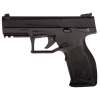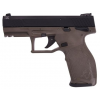Originally published 12/4/2024

Ammo isn’t getting cheaper. With Winchester announcing price increases coming in January, it does not look like we’ll ever see those eight-dollar boxes of 9mm again. Rimfire ammo still remains fairly cheap, and a lot of folks turn to rimfire rifles and handguns to scratch that shooting itch. With that idea in mind, I wanted to ask the question: can skills learned on a.22LR trainer translate to shooting a centerfire firearm?
A .22LR trainer is a rifle or pistol designed to resemble and handle in a way similar to that of a centerfire firearm. Dedicated .22LRs like the Ruger Mk series are great for lots of practice and training, but I wouldn’t consider those to be .22LR trainers. Guns like the S&W M&P 15-22, the Taurus TX-22, Sig Sauer P322, and numerous conversion kits.

They don’t have to match a weapon perfectly but should be close enough. My headline is asking a question, but I think we know the answer. Any practice with a firearm is beneficial to firearm skills. If you train in anyway you’ll be better. My question really should be how much do .22LR trainers translate?
The .22LR Trainer and Training
Live Inventory Price Checker
|
|
Taurus TX22 .22LR Pistol, 3.6" Barrel, Blade Front/Adjustable Rear Sights, Black - 1TX2223110 | Palmetto State Armory | $ 366.99 $ 329.99 |
|

|
Taurus TX22 .22LR Pistol, 3.6" Barrel, Blade Front/Adjustable Rear Sights, Black - 1TX2223110 | Palmetto State Armory | $ 380.99 $ 311.99 |
|
|
|
Taurus TX22 Compact 22lr Pistol NMS 3.5" 13rd, Black - 1-TX22231 | Palmetto State Armory | $ 399.99 $ 229.99 |
|

|
Taurus TX22 .22lr Pistol, ODG/Blk - 1-TX22141O | Palmetto State Armory | $ 449.99 $ 349.99 |
|
My idea to figure out how much a .22LR Trainer can translate is to grab one and a gun that matches and just start shooting to figure it out. My idea was to take a .22LR handgun and a 9mm handgun of similiar size and design and see how much shooting with the .22LR can help me with shooting the 9mm.

To establish a baseline, I used a simple series of tests with a shot timer to judge any skill building. The tests include:
- Quick Draw – Draw and fire two rounds on an A-Zone target from seven yards as fast as possible.
- Reload Drill – Fire one round, reload, and fire one round from the slide lock.
- Mozambique Drill – The classic two-to-the-chest, one-to-the-head test as fast as possible.
- Bill Drill – Draw and fire six rounds to an IPSC-sized A-zone at seven yards as fast as possible.

The testing procedure would be simple. On training day one, I’d go to the range and shoot these tests with the 9mm cold—no practice. Then, for the next ten training days, the 9mm would sit in the safe, and I’d run all of these drills with the .22LR Trainer.
The 9mm and .22LR Trainer
I had to find two guns that matched each fairly well and that turned out to be pretty easy. For the 9mm I went with an Arex Delta Gen 2, a compact striker fired 9mm handgun that’s pretty standard.The .22LR trainer would be the Taurus TX-22, which is a firearm I’ve become extremely happy with.
The guns are very similar. The Arex Delta and TX-22 are similar in size, capacity, sights, and more. They are both generic polymer frame semi-auto handguns, making them a great pair.

Not only are these two guns very similar, but they both work in my Safariland GLS holster. This pro-fit holster requires little adjustment to change from gun to gun. This specific holster has a quasi-universal design and features the Grip Lock system, which deactivates when you grip the firearm. It’s a neat security device and a handy one.

I used the Confidant 2.0 magazine pouch for the magazine. It fits both the Arex Delta and TX-22 magazines without an issue. I thought it was important to ensure the gear was identical between the .22LR trainer and the 9mm handgun.
The Results
On day one, I shot the four drills cold with the 9mm. My times were not impressive, but I haven’t done much shooting with this Arex Delta Gen. 2 model. My times were as follows:
- Draw To Double Tap – 2.14 Seconds
- Reload Drill – 4.95 Seconds
- Mozambique Drill – 1.96 seconds
- Bill Drill – 3.26 seconds

Nothing too impressive. For the next 10 days, mostly in a row, I fired these same drills at least five times with the .22LR trainer. Most of the time, I fired each drill more than five times but didn’t do a total count. My range time never exceeded an hour, so it was never a long training day.
After those ten practice sessions, I fired the same drills cold, and my results with the 9mm Arex Delta were as follows:
- Draw to Double Tap – 1.5 seconds
- Reload Drill – 4.10 Seconds
- Mozambique Drill – 1.67 Seconds
- Bill Drill – 2.50 seconds

It’s clear the difference was fairly broad across most categories. My Bill Drill blew my own mind, and that’s one of the fastest I’ve ever fired with a 9mm handgun. The difference of ten days and about a brick of .22LR can make it significant. It’s worth mentioning that I used to shoot handguns a lot more and did revive muscle memory. If you’re new to handguns, then I wouldn’t expect ten days of training to give you the exact same results.
However, you will see results.
How To Get The Most Out of a .22LR Trainer
The biggest difference between the 9mm and .22LR trainer was recoil. When you start training with a .22LR platform its easy to get slack on your grip and recoil control. Don’t do that. That becomes a habit and your 9mm will get away from you when you start going back to centerfire handguns. Always exercise the same recoil control, grip, and stance with the .22LR trainer that you’d exercise with the 9mm handgun. This will help you keep those recoil control habits.

I’d also suggest a similar degree of accessorization between guns. If it’s a handgun, a similar holster and mag pouch are smart to have. If it’s a rifle, a similar optic, sling, etc. is smart to have. You can make sure your .22LR trainer matches the centerfire gun it’s imitating. Shot timers and targets will measure performance, so make sure you study both as you train.
Finally, I suggest interrupting your rimfire practice with centerfire practice every five to ten rimfire sessions. This will ensure that you’re not losing the edge with your centerfire guns, especially in the recoil department.

Training with rimfire ammo is much cheaper and can help sharpen skills in numerous ways. It still takes time, effort, and ammo, but only one costs you your hard-earned dinero.
SIG P322 Rimfire Handgun – Most Reliable 22LR Pistol Ever Made? ~ VIDEO
About Travis Pike
Travis Pike is a former Marine Machine Gunner, a lifelong firearms enthusiast, and now a regular guy who likes to shoot, write, and find ways to combine the two. He holds an NRA certification as a Basic Pistol Instructor and is the world’s Okayest firearm’s instructor.








I’m an old guy. Carried a SIG 228 for work. When I retired, I purchased a SIG 228 and promptly purchased a 22 upper for the pistol. I can practice with the 22, taught my kids with the 22 upper and will soon teach my grandkids. Haven’t looked into it, but I don’t know how many manufactures do this any longer. My 228 was German. I also purchased two extra barrels, regular and threaded, plus a lot of misc. parts. This was way back when parts were inexpensive. It is not a safe queen!
With the price of ammo rising, there is another question.
Is it better to practice with a .22 or not practice at all?
200 rounds of 9mm is ~$50, 5 practice sessions would cost $250.
200 rounds of .22 is ~10 and 5 practice sessions would be $50
I cannot afford $250, I can afford $50.
And it only get worse with 556. that is about $100/session.
Is it better to pratice once a month with a 9mm?
Or is it better to practice 5 times a month with a .22.
Does dry-firing help? Of course it does. Is dry-firing and/or training with a .22 all you need to do to become proficient with a larger caliber? Of course not! On pistol day I always shoot multiple calibers.
On rifle day, I’ll shoot the Henry H001, (.22lr), a couple hundred times before I pull out the H010G, (45-70), for the final couple dozen shots. For extra fun sometimes I’ll swap the two with each shot. I absolutely do NOT do this with my green students. Even experienced shooters can get terribly unnerved by this exercise.
My first handgun was a Smith and Wesson 422 and I learned to shoot handguns with it and now I shoot a 1911 -10mm for bear defense . The 22 pistol introduced me to handguns and made me want to upgrade to a larger caliber .
I’m surprised he didn’t shoot a Glock 19, 9mm and a Glock 44, .22LR. Identical except caliber.
But I still don’t think a lighter caliber such as a .22LR can make up for training for a 9mm, or any other centerfire pistol or rifle cartridge.
No…nuff said.